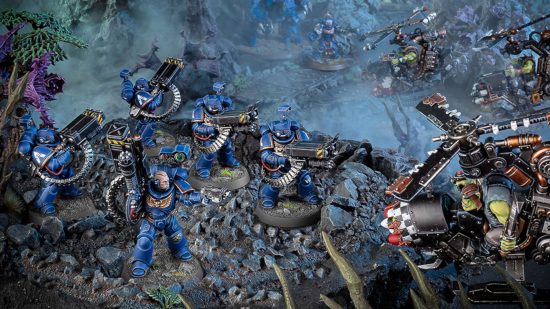Games Workshop has released a major Warhammer 40k points update, and tweaked the key ‘Strands of Fate’ rule for the Craftworld Eldar army, in an effort to rebalance the new edition. Published on the Warhammer Community website on Wednesday, the Warhammer 40k points update substantially increases the cost of units with the Towering keyword or Indirect Fire weapon ability.
The updated Munitorum Field manual makes points changes for most Warhammer 40k factions. The biggest single increase comes for the Eldar Wraithknight, which goes up by 115 points, from 370 to 485. Imperial Knights and Chaos Knights see points increases almost across the board, and the Orks‘ Morkanaut (but not Gorkanaut) goes up as well.
Every Astra Militarum artillery piece sees a points increases, as do Grey Knights Purgation Squads, Eldar Nightspinners… anything with an Indirect Fire weapon. A max sized Space Marines Desolation Squad costs 100 points more than it used to.
The Craftworld Eldar’s “Strands of Fate” rule is still substantially the same: it allows the Eldar player to roll a set of dice at the start of the game, store the results, and use the stored values in later instead of rolling a die. The version in the revised Eldar Index limits the Eldar player to using just one Fate die per phase.
A minor, but welcome, change in the Munitorum Field Manual adjusts the listings for Black Templars Primaris Sword Brethren and Death Guard Plague Marines. The largest Sword Brethren unit is now 10 models, not 11, and it’s now possible to field a squad of seven Plague Marines, rather than just five or 10.
The changes bring both sets in line with the number of models in their respective model kits. YouTubers ThePaintingPhase provide a good illustration of community sentiment about the previous discrepancy:

You can download the updated Munitorum Field Manual and the updated Index Aeldari from the Games Workshop website. In the WarCom post announcing the changes, Games Worskhop says “The next round of balance adjustments will be coming in the autumn quarterly update later this year”, and we can also expect “an extra errata clearing up a few more discrepancies in the Indexes towards the end of July” that won’t have any balance patches.
Competitive players have been concerned that 40k’s game balance was substantially skewed since GW released the core rules and faction Index books for 10th edition.
The Towering keyword allows a unit to see, and be seen by, units on the other side of Ruins terrain using normal line of sight rules. Though this makes them big targets, it gives them an unparalleled ability to see across the battlefield.
The Indirect Fire weapon ability is more powerful than it was in the previous edition, and units with Indirect fire weapons don’t need to risk exposing themselves to return fire or the powerful new version of the ‘Fire Overwatch’ core stratagem.
The Eldar Wraithknight was a particular menace, due to its Heavy Wraithcannon. This weapon is a tank and infantry killer with D3 Attacks, the Blast ability, and 2D6 damage.
It also has the Devastating Wounds ability; critical wound rolls (normally on a to-wound roll of a six) turn the weapon’s damage into mortal wounds, ignoring the saves or invulnerable saves of enemy tanks and allowing excess wounds to spill through infantry units.
With the original Strands of Fate wording allowing the Eldar player to substitute any number of dice in each phase, every six in the fate dice pool converted directly to 2D6 mortal wounds the very first time the Wraithknight fired. And with the new Overwatch stratagem, even if the Eldar didn’t get to activate first, they could still unleash this devastastion as soon as their opponent moved.
We spoke to a tournament organiser, part of a group famous for pre-emptively banning the Leagues of Votann army before its Warhammer 40k Codex was even released, to explain why he and his peers considered 40k 10th edition “clearly not balanced” for competitive play. These updates from GW respond to some, but not all, of the group’s concerns. GW released a tournament play companion document last week that seeks to address similar concerns.



